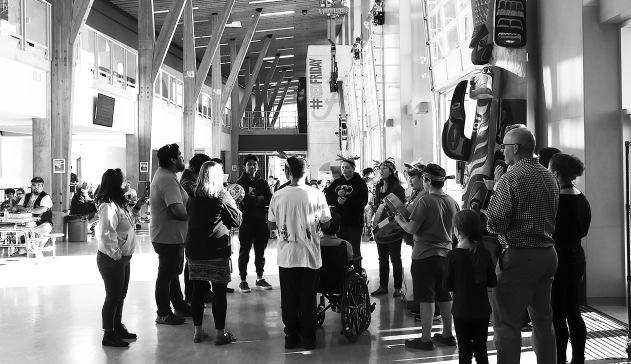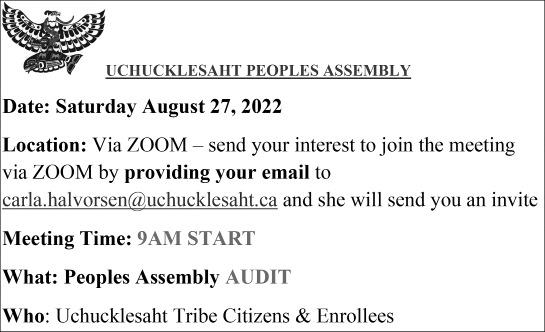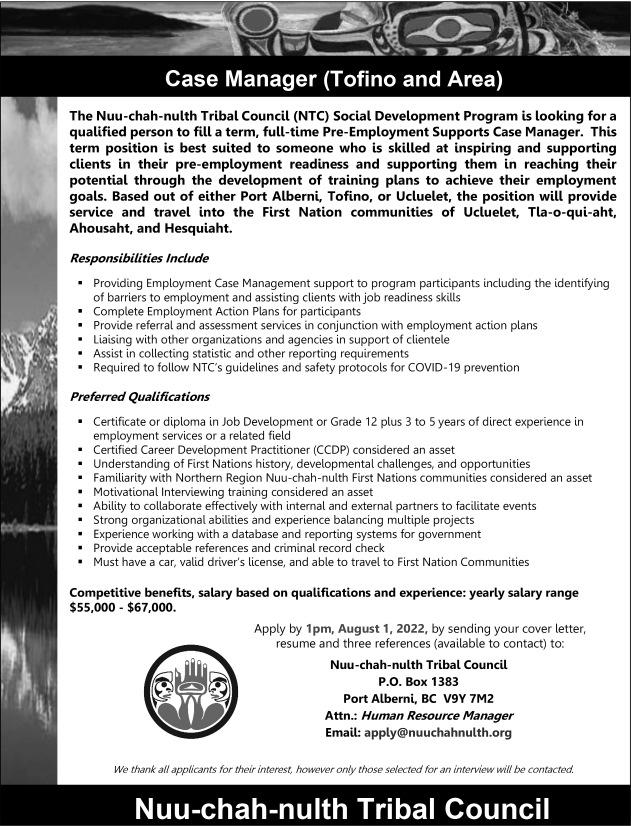
13 minute read
High school grades come to Bamfi eld
In the next school year Bamfi eld and Anacla students can pursue secondary studies at the village’s local facility
By Eric Plummer Ha-Shilth-Sa Editor
Advertisement
Bamfi eld, BC - As a sign of Bamfi eld and Anacla’s continued growth, the area’s community school is preparing to take in high school grades in the fall, off ering local teenagers the opportunity to pursue their secondary education at home. After sitting at under 100 residents for years, the Huu-ay-aht village of Anacla has grown to over 150 residents since 2020, with more homes being built as the First Nation encourages its members to return to their ancestral territory. With a population of approximately 200, Bamfi eld is also preparing for growth, the anticipated outcome of extensive improvements to the rugged 80-kilometre road from Port Alberni. Work on Bamfi eld Main is underway, with a surface chip-sealing and partial paving of the route expected to be complete by the fall of 2023. Huu-ay-aht Councillor Edward Johnson said the First Nation approached School District 70 over the last year with the needs of a growing village. “We have some parents in community and their children want to move back home,” he said. Previously high-school-age students from Anacla and Bamfi eld had to leave the remote communities to attend classes in Port Alberni or elsewhere, boarding with another family for the school year. Johnson did this as a teenager after his parents moved back to Anacla, making the tough decision to attend high school in Nanaimo. “There was a part of me that wanted to stay in community, but then the organized sports is what I wanted to participate in,” he said. “If you’re able to board out in a good house with good teachings, then you’re set. But it you’re not, I think that’s where families end up picking up and moving right out of community so that they can have their children connected to family still and have their education.” But during the COVID-19 pandemic many students came back to Anacla to pursue online learning, said Dave Maher, principal of the Bamfi eld Community School. The small school also saw its numbers grow over the last year to 29. “The student enrolment of the school was steadily increasing all year long, and there was a number of secondary-aged
Photo by Eric Plummer Teenagers in Bamfi eld and the nearby Huu-ay-aht village of Anacla will soon have the option of staying home for high school, with the expected expansion of the remote community’s school. students, due to COVID and other family reasons, [who] were returning to Anacla,” he said. “That ultimately made a very strong case to be able to fund a secondary teacher at Bamfi eld Community School.” Now the school is expecting around 45 students in September, an enrollment that will enable a third teacher to be hired. “We have an incredible secondary teacher coming to us, a Bamfi eld local,” added Maher. “We’ve very excited to have her back in the building to compliment a very experienced head teacher, who has 20 years of teaching experience and who will spend the rest of her teaching career leading Bamfi eld Community School, as well as a very passionate and capable primary teacher.” Some classes, such as Grade 11 chemistry, physics, pre-calculus math and Grade 12 anatomy-physiology, will be off ered online through the Eight Avenue Learning Centre in Port Alberni, where Maher is also the principal. Other opportunities are expected through a partnership with the Bamfi eld Marine Sciences Centre. Despite the signifi cant growth in enrolment, space is not a concern at the community school, which has room for three classrooms, a computer lab, an art room and gymnasium. “There’s some great space,” said Maher, noting that the community school went up to Grade 10 in the past. “In it’s heyday, when economic times were very diff erent, there was up to 85, 90 students in the school at most.”
Indigenous grad requirements get positive feedback
By James Paracy Ha-Shilth-Sa Contributor
The results for a survey done by R.A. Malatest & Associates in collaboration with the First Nations Education Steering Committee (FNESC) on Indigenous-focused graduation requirements have been released to the public. A total of 5,657 people throughout B.C. completed the survey, with 58 per cent being parents or caregivers of students and 25 per cent being teachers. Input on the survey was collected from March 7 to April 22. It received generally positive feedback based on a few key areas: implementation timeline, teacher qualifi cations and training, funding and resources, as well as broadening the considerations for eligible course off erings. In terms of negative feedback, respondents were asked to identify one or more classes they didn’t feel should be eligible for credit towards post-secondary graduation. According to the survey, ‘English First Peoples – Spoken Language 10’ received the most negative feedback, with the most common concern being that the class might not be practical or useful in comparison to other available courses. The implementation plan for Indigenous-focused grad requirements is expected to be announced later this summer. According to B.C. Teacher’s Federation’s Suzanne Hall, these requirements will be implemented gradually, and some of the pieces are already in place. “This year is sort of a feedback and planning year,” Hall said. There’s going to be consultation and planning that happens and the requirements is starting the year after that. There currently are a few courses that are widely taught in the system already that we know would meet the criteria, like First Peoples 11 and First Peoples 12, as well as First Nations Studies.” As Hall outlines, the upcoming school year will present districts across the province with an opportunity to run Indigenous-focused courses on a trial basis before they become mandatory in the 2023-24 school year. Hall adds that, in addition to courses available across the province, classes with local cultural ties will come into play eventually while things develop. “Over the course of this next year, the idea will be to see what other courses can be developed and put into place,” explained Hall. “So, some of it will be local as well, some places across the province there would be the ability to put together a local course. There’s a halfway step there for locally developed courses where the school boards can approve a course and it has to meet certain criteria so that it then counts for the kids for credit. So, some of these new courses could be done through the board approval process. The Ministry of Education could work with BC teachers and create new courses as well.” Other than the courses already in place in B.C. schools, English First Peoples courses in writing, spoken language, new media, literacy studies and more will be among courses meeting the new graduation requirement. From the student perspective, the process to register for Indigenous-focused courses will be a familiar one. As they register for courses to earn enough credits towards graduation, an Indigenous-focused course will be a necessary requirement similar to how all students must complete a form of English 12. On the teachers’ side of things, implementing Indigenous-focused courses is something they’ve wanted for a long time. Hall says the B.C. Teacher’s Federation is strongly in support of this kind of expansion in B.C. schools and has lobbied alongside the First Nations Education Steering Committee for the inclusion of Indigenous-focused courses at all levels. “Social justice is a long-embedded vein in the work of the BCTF,” she said. “So, the BCTF as an organization has long supported trying to educate our members and the public about Indigenous issues, working really hard to try to meet the required calls to action from the Truth and Reconciliation Commission. We have long been advocating for the inclusion of, in all our coursework and in all the curriculum that we work on, the inclusion of embedding Indigenous cultural aspects and understanding history into our coursework.” B.C. teachers played a major part in the survey’s feedback, with approximately 1,414 teachers providing their input. In addition to Indigenous-focused courses being available and required in post-secondary schools, the Ministry of Education and Childcare is off ering another option. Students will be able to earn external credits through courses such as First Nations language profi ciency, First Nations drumming and/or dancing and First Nations carving and traditional art. Although this external credit option for cultural learning is coming into place alongside B.C.’s Indigenous-focused graduation requirements, it does operate separately from the provincial graduation requirement.

Photo by Deborah Potter First Nations students are welcomed to the Alberni District Secondary School in 2019. With one third of the school district identifying as Aboriginal, SD70 has worked to incorporate a curriculum that refl ects its student population.
Page 16— Ha-Shilth-Sa— July 21, 2022 President’s message to Nuu-chah-nulth-aht
Hello everyone. Hope everyone is enjoying summer and getting lots of fi sh to eat now and into the winter months. It’s a lot of work but well worth it throughout the year. Again, my deepest sympathies to families and communities who have had a loss of a loved one. Highlight of the past month of course was four days at the Assembly of First Nations Annual General Assembly in Vancouver. There were well over 2,000 delegates but only about 400 chiefs or proxies. The big issue was the national chief and whether she should be let go. RoseAnne Archibald, the national chief, has been advocating to have AFN looked into to ensure there were no bad fi nancial practices. It was one thing she promised as she ran for national chief. At the top of her agenda was to ensure there were no unfair employee pay outs of their contracts, and no issuing of contracts to individuals and companies that were not needed. There have been rumours of such unfair practices for years and it is time to clear up these rumours and ensure they are not happening and that we have transparent, accountable policies in place to make sure there are no corrupt practices. While a lot of time was spent on this issue over the four days, it was important to set in place a process to clean up or fi x the AFN. It is an important advocacy arm to follow up on important issues with our First Nations. In the end, the national chief is to continue in her role. The committee on constitutional reform is to look at the policies and make recommendations on fi nancial policies and if there should be a forensic audit. This work must be done by the December AFN special meeting. There are also provisions for a healing processes to be done within the executive. There is a need for that as the executive had suspended the national chief. They need to continue to work together in a good way to keep the organization fulfi lling its mandate and resolutions of the chiefs. The executive and national chief are to cooperate with an ongoing independent investigation into allegations of staff harassment by the national chief. It was a diffi cult meeting and much was said, but in the end the motion to fi x the AFN was approved with the national chief carrying on her duties. A presentation was made regarding the fi nal agreement on children and families included the $20 billion for children who were in care and did not get supported properly, or under Jordan’s Principle. Details of how the money will be rolled out to individuals are still being reached and this is subject to approval by the Canadian Human Rights Tribunal and the federal court. I have been doing work on climate change and take part in high-level discussions both provincially and federally on achieving net zero of greenhouse gas emissions. There is a lot of work yet to be done to ensure there is net zero emissions for 2050. More actions as opposed to talk. Action plans to get us away from oil and gas. The government of Ecuador entered into an agreement with Indigenous peoples that there would be no more expansion of oil and gas in the Amazon, which is a big step forward and I hope Canada will do its transition off of oil and gas. The federal government just rolled out over $870 million for disaster fi nancial assistance and climate resiliency. First Nations are unduly impacted by climate change and we must work on preparing ourselves for future disaster. The First Nations Summit had meetings as well. Congratulations to Hugh Braker who is now on the First Nations Task Group. A lot of work on UNDRIP is being done by the summit and Hugh will be very busy with this work. I continue my work on the Heritage Conservation Act. There are dialogues starting with First Nation communities all over B.C. on how we can improve protections for sacred sites, burial sites, and cultural artifacts. You will be asked how you want to participate in this dialogue, with your fi rst Nation. In person? Over Zoom? With your elders and cultural people? And you will be asked what your priorities are for heritage. We received money from the federal government to do work on what actions we want the federal government to take in areas of federal jurisdictions, such as fi sheries, climate change, marine protected areas, violence and racism, health, education and children and families. Your First Nations will be contacted by our facilitators that will be doing the work with you. This is important work as we need to tell the federal government what they need to do in each of our priority areas and also what laws we need changed. These discussions will be held in community or possibly on Zoom as COVID numbers continue to climb and the 7th wave of COVID has hit us. The work has begun on the old Alberni Indian Residential School site using ground penetrating radar to determine where there are unmarked graves of the children who did not make it home. These are diffi cult times and I encourage you to seek any kind of counselling or cultural support from the NTC and Tseshaht Nation who have established people to help with any kind of triggers that may happen. While this is necessary work that needs to be done, it is hard work, hard on all of us. All Nuu-chah-nulth Nations had people who went to AIRS and there were over 100 First Nations who had their children at the school. We all need to support one another during these times especially when we know the results of the scans. Keep safe, keep up the good work in the communities where we are looking after our territories, managing our resources as much as we can, and providing services that are much needed in our communities.
Cloy-e-iis, Judith Sayers




Port Alberni Friendship Centre Volunteers Needed
Need work experience? The Port Alberni Friendship Centre is looking for interested applicants for various positions. Call 250-723-8281


More job posting at www.hashilthsa.com






